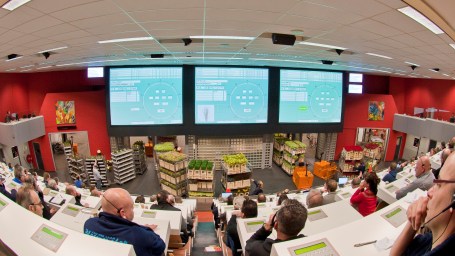5/5 (6) Sephora is an American beauty brand and cosmetics retailer and also an innovative global business which has been known to “do things a little differently”. The launch of Sephora’s website occurred already in 1998, allowing them to operate as an early player within electronic commerce (Bornstein, 2014) and later also social commerce.
Social commerce is the combination of e-commerce and social media. It is a term often used to describe new online retail models or marketing strategies that incorporate social networks and/or peer-to-peer communication to drive sales (Indvik, 2013). The global social commerce market has an estimated size of $30 billion (Euromonitor, 2015). Moreover, it shows impressive growth potential of almost 200%
(Smith, 2015). It was forecasted to represent 5% of online retail revenue in 2015 (Morison, 2014) and expected to grow further. Social commerce offers a unique approach by disrupting traditional marketing taxonomies of bought and owned media. With this new, “earned” concept, customers are no longer customers but rather become “fans” of the brand. Although, these new social media outlets (SMOs) have a somewhat narrow reach and a somewhat homogenous audience, they offer an immense business opportunity. This development constitutes a completely new customer relationship for businesses, which they need to learn to develop in order to leverage the great potential offered by the Internet and social commerce especially. In fact, this potential goes beyond basic user acquisition. It creates a soil for more cost effective R&D, customer service and data management. Data generated and measured through social platforms can, in turn, be leveraged for future marketing efforts and product launches.
In 2012, Sephora released an application, optimising mobile sales leading to a 167% increase in orders, which now accounts for approximately a third of mobile traffic. The most important and best developed parts of the website were incorporated in this application, allowing for an improved and unique customer experience ultimately leading to increased sales and customer loyalty (Cameron, 2013). Sephora’s revenues were €1.94 billion in 2012 (Sephora, 2016). In 2013 these revenues, according to Forbes, increased up to over $4 billion. This is said to be due to the launch of Sephora’s online store, currently serving approximately 1700 store in 30 countries in the whole world (Loeb, 2013).
In 2010 the Sephora team developed a platform called “Beauty Talk” where customers could engage with each other, whilst remaining anonymous and safe (Ofek & Berkley Wagonfeld, 2012). The interest in the platform was high from the beginning. Yet, the Sephora team wanted to encourage users to share their knowledge and experiences more and, thus, they created a “leaderboard” with 35 levels ranging from newcomer to beauty master, depending on the amount of a user’s posts. Upon registration for the “Beauty Board” users register an account and build a highly personalised profile based on their demographics and preferences. This generated data is one very important outcome of implementing social commerce models (Mau, 2013). With the help of the personal data, Sephora gains access to entirely new opportunities of customer interaction. Firstly, this personal data allowed the company for more specific personalisation of their products, the shopping experience for their customers, and their marketing efforts. Hence, social commerce empowered the delivery of personal brand experience (Tode, 2016). Furthermore, the collected personal information transforms anonymous customers into recognised entities. Once individuals are entities, marketing strategies can be personally targeted to each individual customer. In fact, data collection assists Sephora in enriching the user’s experience with the brand. Additionally, big data grants the entity complete control over the online customer experience. Next to the ease and comfort within product search and selection due to personalisation, the company can establish a close trust relationship to their customer base.
The platform was developed in collaboration with a company called Lithium. According to Lithium’s chief Michael Wu, the platform has over 400 metrics, which are being used to track users’ engagement. This reaches from content engaged with, up to the general behaviour on the platform of the user. Sephora, thus, gains knowledge about customers’ social relationships and preferences concerning their purchasing (Ungerleider, 2014). Hence, Sephora also understands how to utilise their customers in a way that they and also Sephora, itself, retrieves maximum utility as explained by Bridget Dolan, Head of Digital at Sephora: Consumers are “the best sales people we have in our stores because these women really know about beauty – they really love it” (Fiorletta, 2014).
The resulting social network enabled Sephora a whole new way of customer service: peer-to-peer reviews. They gained more accurate problem descriptions and frequently asked questions. Moreover, they were able to recognise and react proactively to developing trends. These inter-customer reviews do not only save manpower for Sephora, they can also give access to new ideas and methods. As a result, they can offer higher quality customer service to other channels (Tode, 2016). It is important to mention that Sephora did not stop their online efforts after implementation of their own social media sites. They continue their role as an early adopter and are, thus, able to tap into new opportunities as soon as they come up. What do you think?
Bornstein, J. (2014). How Sephora Reorganized to Become a More Digital Brand. Harvard
Business Review. [online] Available at: https://hbr.org/2014/06/how-sephora-reorganized-to-become-a-more-digital-brand/
Cameron, M. (2013). Sephora’s World Leading Digital Platform. The Social Media Monthly. [online] Available at: http://thesocialmediamonthly.com/sephoras-world-leading-digital-platform/
Euromonitor, (2015). Internet Retailing in Germany. [online] Euromonitor. Available at: http://www.euromonitor.com/internet-retailing-in-germany/report
Fiorletta, A. (2014). Sephora Drives Advocacy With BeautyTalk Program. [online] Retailtouchpoints.com. Available at: http://www.retailtouchpoints.com/features/retail-success-stories/sephora-drives-advocacy-with-beautytalk-program
Indvik, L. (2013). The 7 Species of Social Commerce. [online] Mashable. Available at: http://mashable.com/2013/05/10/social-commerce-definition/#AeP5T.YaSOq7
Lithium, (2015). The Sephora story.
Available at: http://www.lithium.com/why-lithium/customer-success/sephora
Loeb, W. (2013). Sephora: Department Stores Cannot Stop Its Global Growth. Forbes. [online] Available at: http://www.forbes.com/sites/walterloeb/2013/04/18/sephora-department-stores-cannot-stop-its-global-growth/#33a34332286f
Mau, D. (2013). [online] Fashionista.com. Available at: http://fashionista.com/2014/03/sephoras-social-shopping-platform-is-here
Ofek, E. and Berkley Wagonfeld, A. (2012). Sephora Direct: Investing in social Media, Video, and Mobile. 1st ed. Cambridge: Harvard Business School, pp.2-24.
Sephora, (2016). About Us | Sephora. [online] Available at: http://www.sephora.com/contentStore/mediaContentTemplate.jsp?mediaId=10800104
Tode, C. (2016). Why brands could own social commerce, not the big platforms – Mobile Marketer – Social networks. [online] Mobilemarketer.com. Available at: http://www.mobilemarketer.com/cms/news/social-networks/17474.html
Ungerleider, N. (2014). How Sephora Discovered That Lurkers Are Also Its “Superfans”. [online] Fast Company. Available at: http://www.fastcompany.com/3035236/how-sephora-discovered-that-lurkers-are-also-its-superfans



